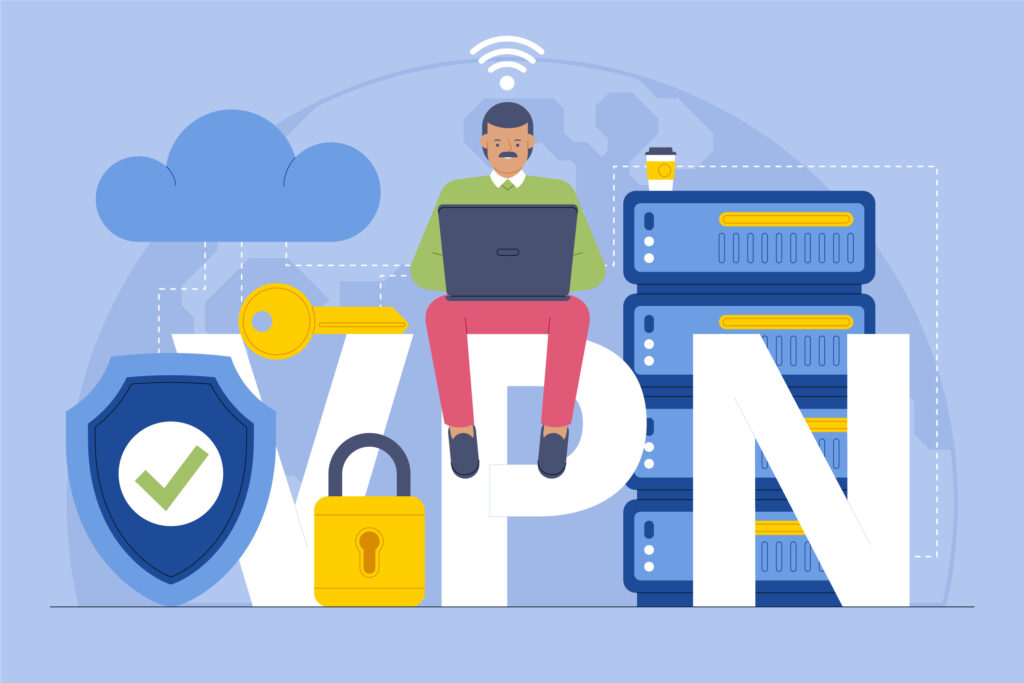Introduction
For growing startups, every digital asset—from cloud servers to internal collaboration platforms—relies on a secure and stable network. However, as infrastructure scales, so do the risks. A misconfigured firewall rule, outdated proxy, or unmonitored VPN tunnel can open the floodgates to cyber threats. Network vulnerabilities don’t just stall operations; they endanger reputation, customer trust, and even legal compliance.
According to IBM’s 2023 Cost of a Data Breach Report, the average breach costs small businesses $3.3 million—primarily due to misconfigured access controls and insecure networks. For early-stage companies operating with lean IT teams, these threats are both existential and invisible until it’s too late.
Fortunately, proactive auditing and security measures, especially with tools like VPNs, firewalls, and proxies, can mitigate these risks effectively. When integrated into a unified IT strategy with support from a reliable Network Service Provider (NSP) or Managed Services Provider (MSP), these tools transform reactive defense into proactive governance—fueling safe scalability and long-term networking energy savings for business.
Apply Encryption to Data
Encrypting data at rest and in transit protects sensitive business information, financials, and customer records from unauthorized access—even if the system is breached. Encryption renders stolen data useless without decryption keys.
- Protects sensitive data from being readable by attackers
- Essential for GDPR, HIPAA, SOC 2 compliance
- Apply TLS/SSL for web apps and services
- Encrypt email communication with S/MIME or PGP
- Use full-disk encryption on company devices
- Secure backup files with AES-256 encryption
- Encrypt cloud storage using platform-native encryption keys
What is Proxy Firewall and How Does It Work?
A proxy firewall acts as a gateway between users and the internet, inspecting traffic and acting on behalf of the user, adding a strong security layer. Unlike basic firewalls, it operates at the application layer, preventing malicious traffic from ever reaching internal systems.
- Filters traffic based on content, not just port/protocol
- Masks internal IPs from the external world
- Blocks direct communication with suspicious destinations
- Ideal for filtering web and application access
- Prevents data leakage by inspecting outbound traffic
- Logs user activity for audit trails
- Useful for enforcing organizational browsing policies
Audit and Secure Your Network with VPN
Virtual Private Networks (VPNs) create encrypted tunnels between endpoints and internal resources, ideal for securing remote access. Auditing VPN usage helps validate authentication methods, traffic types, and policy adherence.
- Encrypts traffic over insecure Wi-Fi networks
- Validates identity before granting access to systems
- Allows secure connection to internal servers
- Split-tunneling can be restricted for safety
- VPN logs help detect anomalies
- MFA enhances VPN login security
- Segment user access via VPN policies
Audit and Secure Your Network with Firewalls
Firewalls remain the cornerstone of network perimeter defense. Regularly auditing firewall configurations ensures ports aren’t left unintentionally open and that traffic rules reflect your business logic.
- Block unused ports to reduce attack surface
- Review firewall logs to detect brute-force attempts
- Set rules by IP, application, and protocol
- Prevent lateral movement within the network
- Use next-gen firewalls with intrusion prevention
- Schedule monthly rule-set reviews
- Automate policy updates with central management tools
Audit and Secure Your Network with Proxy Configurations
Proxies control internet traffic and help enforce security policies. Auditing ensures only approved endpoints are accessed and employee internet usage complies with policy.
- Configure proxy to filter malicious domains
- Restrict usage to approved apps and URLs
- Monitor access logs for abnormal behavior
- Block direct access to shadow IT services
- Implement authentication on proxy use
- Enforce bandwidth usage policies
- Regularly update proxy blocklists and whitelists
Features and Benefits
A unified security posture includes redundancy, visibility, control, and compliance. The right mix of VPN, firewall, and proxy creates a multi-layered defense.
- Layered security across device, application, and data layers
- Reduced attack surface through strict traffic controls
- Centralized visibility into user and network activity
- Faster detection and response to incidents
- Compliance alignment with security frameworks
- Scalable infrastructure security for hybrid teams
- Protects cloud-native and legacy environments alike
Install Anti-Malware and Antivirus
Antivirus and anti-malware protect endpoints from viruses, ransomware, and spyware. These tools must be updated and managed centrally to avoid gaps.
- Detects malicious downloads before execution
- Prevents ransomware encryption attempts
- Identifies rootkits and spyware
- Supports behavioral analysis for unknown threats
- Quarantine suspicious files for review
- Centralized console for monitoring and updates
- Integrate with SIEM for threat correlation
Update Software Often
Outdated software is a primary attack vector. Automating patch management across endpoints and servers reduces vulnerabilities while maintaining compliance.
- Apply OS and application patches regularly
- Subscribe to vendor security advisories
- Schedule patch testing in sandbox environments
- Automate updates using centralized MDM tools
- Prioritize patches by CVSS severity
- Document patch history for audits
- Rollback procedures in case of issues
Create Strong Passwords
Weak passwords remain a top reason for unauthorized access. Use tools and policies to enforce strong password creation and rotation.
- Enforce minimum password length and complexity
- Prohibit reuse of old passwords
- Require regular password changes (60–90 days)
- Deploy password managers for secure storage
- Educate users on phishing resistance
- Detect and alert on compromised credentials
- Integrate with SSO platforms for ease
Set Up Two-Factor Authentication (2FA)
2FA protects accounts even if passwords are compromised. It’s now a standard practice for securing critical systems and user accounts.
- Use authenticator apps or hardware tokens
- Enable 2FA for VPN, email, cloud platforms
- Block access without second-factor verification
- Provide backup codes for device recovery
- Track 2FA success and failure logs
- Educate users on avoiding social engineering
- Use conditional access based on geography
Educate Employees on Cybersecurity
Human error is a leading cause of breaches. Regular training helps employees recognize and respond to threats like phishing or insider risks.
- Conduct phishing simulation exercises
- Share monthly security awareness newsletters
- Include cybersecurity in new hire onboarding
- Make training mandatory and track completion
- Offer role-specific guidance (developers, HR, finance)
- Review social engineering scenarios
- Promote a “report-first” culture for suspicious activity
Why is Securing a Network Important?
Network breaches result in more than downtime—they cause data loss, regulatory violations, reputational damage, and revenue loss. Internet Security is a business enabler, not just an IT issue.
- Preserves data confidentiality, integrity, and availability
- Ensures operational continuity under attack
- Protects intellectual property and customer data
- Builds stakeholder and investor trust
- Avoids regulatory penalties and class actions
- Supports safe innovation and scalability
- Enables secure remote collaboration
Secure Configuration Management
Maintaining a baseline configuration across all devices prevents deviation and misconfigurations that create vulnerabilities. Standardization increases audit readiness.
- Establish golden image baselines
- Monitor config drift and unauthorized changes
- Use tools like Ansible, Puppet for consistency
- Store config versions in version control
- Enforce lockdowns for critical servers
- Review configurations quarterly
- Define approved OS and application versions
Role-Based Access Control (RBAC)
Restricting access based on roles minimizes potential abuse. Every user should only access what’s necessary to do their job.
- Use least-privilege as default policy
- Create role groups in AD or IAM
- Enforce approval workflows for access elevation
- Audit access logs and changes regularly
- Remove dormant accounts proactively
- Enforce session timeouts
- Align with compliance standards (ISO 27001, HIPAA)
How Infodot Can Help Auditing and Securing Your Network
Infodot offers end-to-end IT security services tailored for startups and SMEs. From VPN deployment to firewall management and proactive proxy audits, Infodot ensures airtight infrastructure security.
- Automated VPN configuration and 24/7 monitoring
- Firewall rule audits and active defense tuning
- Proxy filtering and policy enforcement
- Endpoint protection and vulnerability management
- User awareness training and incident simulations
- Compliance-ready reporting and documentation
- Integrated SIEM, backup, and DR planning
Real-World Example 1: Startup Avoids Ransomware via Proxy Configuration
A fintech startup faced recurring malware alerts traced to unsecured user browsing. Infodot deployed secure proxy configurations to filter malicious URLs and enforce access policies. Staff received training, and incident frequency dropped 80% within 2 months. Logs showed a complete block of phishing redirection attempts, saving critical customer data.
Real-World Example 2: VPN Misuse Leads to Breach Attempt
A remote employee’s personal VPN routed traffic outside corporate controls. Infodot identified the unapproved VPN during a routine audit and transitioned all employees to a managed VPN with strict rules. This move closed the exploit window and established user-level visibility, preventing further policy violations.
Real-World Example 3: Firewall Audit Saves SaaS Startup from Data Exposure
During a quarterly audit, Infodot found open ports on an idle development server. Although unused, the ports exposed legacy admin tools. Within hours, the ports were closed, and the server decommissioned. Without that audit, the server could’ve become an easy entry point for attackers.
How to Audit and Secure Your Network with VPN, Firewalls, and Proxy Configurations
Auditing and securing your network requires a layered approach that integrates firewalls, proxies, and VPNs—each playing a vital role in defense. Start by establishing a consistent network design that supports segmentation and role-based access. Use firewall audits to close open ports and validate rule sets.
Ensure all proxies are configured to block risky domains and enforce URL filtering policies. Track proxy usage and enforce authentication. Audit VPNs for endpoint access logs, and apply policies restricting split tunneling and enforcing MFA.
Leverage tools that offer real-time visibility and alerts. Partnering with trusted Network Service Providers ensures consistent monitoring and alignment with compliance goals. This combined strategy not only reduces threats but also supports networking energy savings for business, helping startups scale securely and efficiently.
Conclusion
Securing your startup’s network infrastructure is no longer optional—it’s integral to growth. As threats become more advanced and compliance burdens increase, relying on piecemeal security approaches exposes your business to severe risks.
A unified strategy using VPNs, firewalls, and proxies forms a resilient backbone. But that’s just the start. By layering access controls, real-time monitoring, and employee awareness, startups can operate with the confidence of an enterprise—without the overhead.
With a partner like Infodot, startups can go from patching issues to building a secure digital foundation. It’s not just about locking doors—it’s about enabling safe innovation, customer trust, and scalable growth. Security, when done right, becomes your competitive edge.
FAQs
- How do I audit firewall configuration?
Review rule sets, logs, access lists, and port exposure. - How do I check my proxy and firewall settings?
Use browser/system settings or IT policy documentation. - How will you maintain the security to your network?
With access control, monitoring, encryption, and patching policies. - What is a proxy firewall in network security?
It filters internet traffic between the user and external services. - How do you audit network security?
Assess devices, configurations, traffic logs, and access policies. - What is a VPN used for in businesses?
To encrypt and secure remote connections to internal systems. - What’s the benefit of next-gen firewalls?
Application-layer inspection and real-time threat detection. - What is the risk of misconfigured proxies?
Data leaks, bypassed filtering, and access to malicious sites. - Is antivirus enough to protect networks?
No—it must be combined with firewalls and user controls. - How often should I update firewall rules?
At least quarterly, and after major infra or staff changes. - What is least-privilege access?
Giving users the minimum access needed to do their jobs. - How do you handle network security for remote teams?
Using VPN, MFA, device policies, and zero-trust access. - What logs should I review regularly?
Firewall, VPN, authentication, and endpoint antivirus logs. - What’s the role of 2FA in VPN security?
It prevents access even if passwords are compromised. - How does encryption protect business data?
It renders stolen or intercepted data unreadable. - Can proxies monitor employee productivity?
Yes—with caution and according to privacy regulations. - What’s an IDS and why use it?
Intrusion Detection System; it flags unauthorized activity. - How should VPN logs be managed?
Encrypted, retained per policy, and reviewed monthly. - What is zero trust network architecture?
It verifies each access request as if it’s from an open network. - Can outdated software lead to breaches?
Yes—most exploits target known vulnerabilities in old versions. - What is RBAC?
Role-Based Access Control limits access by user roles. - Should startups use managed firewalls?
Yes—for better uptime, support, and compliance coverage. - What’s the impact of a misconfigured firewall?
Could expose internal systems to internet-based attacks. - How to respond to a security incident?
Follow an incident response plan—contain, eliminate, report, recover. - Are public Wi-Fi networks safe?
No—always use a VPN when on public networks. - How can I enforce strong passwords?
Use policies, SSO integration, and password managers. - Do browser extensions pose a risk?
Yes—especially if permissions or sourcing is unchecked. - How do you monitor proxy usage?
Via logs, dashboards, and alerts for flagged activity. - What’s the benefit of managed IT services?
Expertise, 24/7 monitoring, rapid incident response, and strategic scaling. - Is cyber insurance enough protection?
No—technical controls are still essential to minimize exposure.





